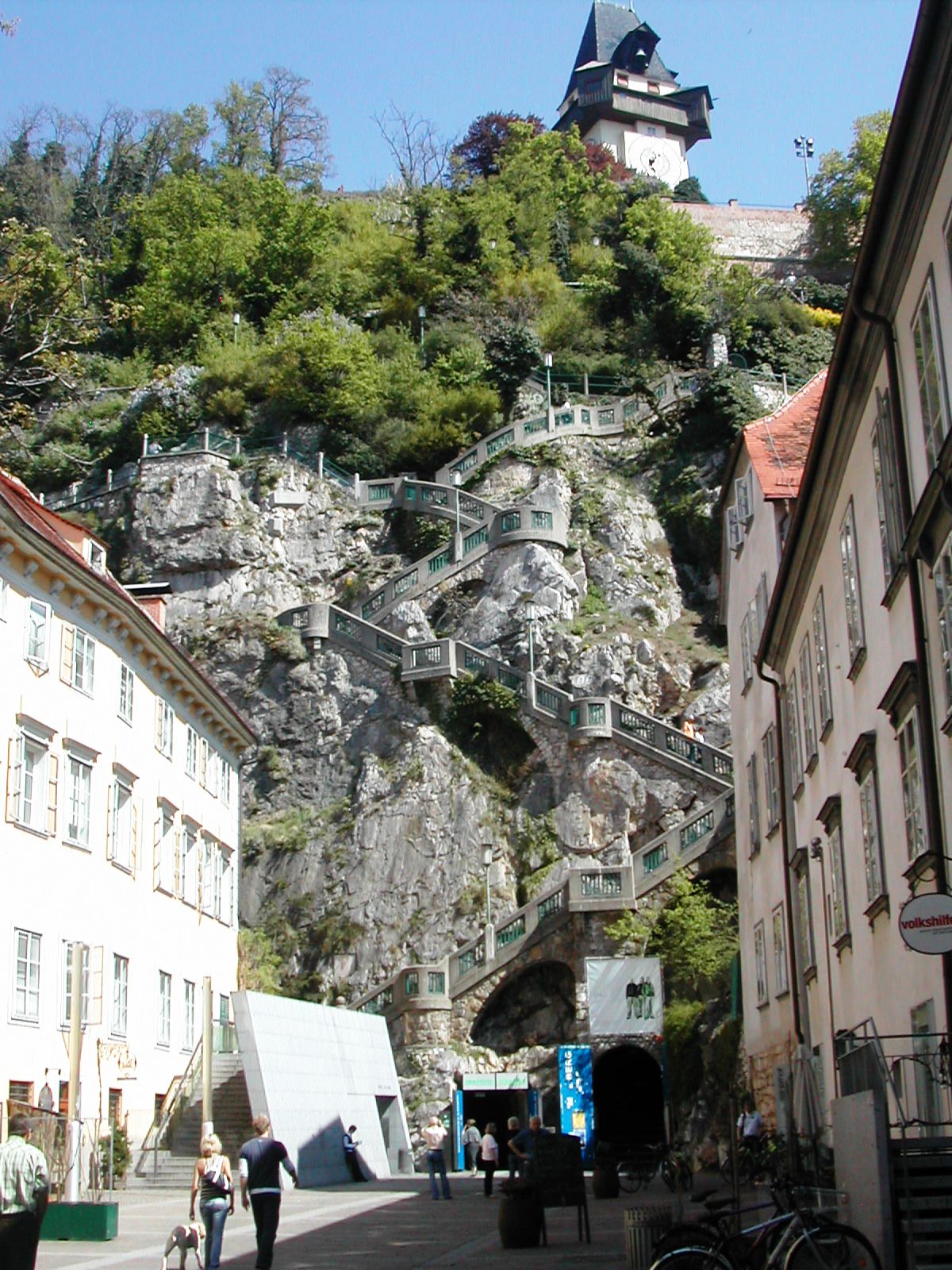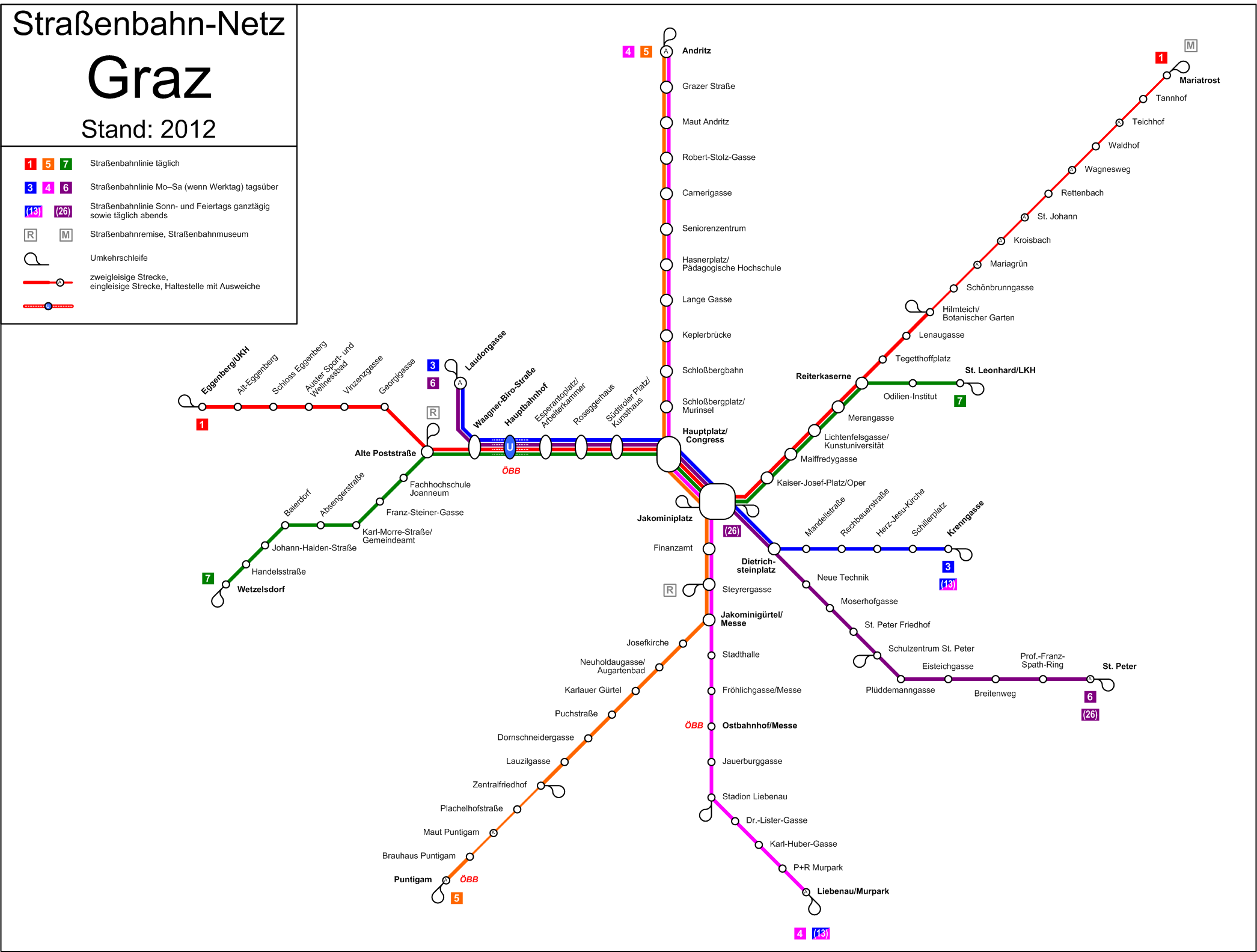|
Timeline Of Graz
The following is a timeline of the history of the city of Graz, Austria. Prior to 14th century * 1180 – Graz becomes capital of the Duchy of Styria. * 1239 – Graz Friary active. 14th–16th centuries * 1379 – Graz becomes capital of Inner Austria; Leopold III in power. * 1438 – Graz Castle built. * 1462 – Graz Cathedral built. * 1560 – Clock tower built on the Schlossberg. * 1585 – University of Graz founded. * 1588 – Belltower built on the Schlossberg. * 1590 – Dobel Castle built. 17th–18th centuries * 1619 – Habsburg Ferdinand II becomes Holy Roman Emperor; relocates from Graz to Vienna. * 1635 – Eggenberg Palace built (approximate date). * 1640 – Mausoleum of Ferdinand II, Holy Roman Emperor consecrated. * 1645 – Styrian Armoury built. * 1652 – Grabenkirche (church) dedicated. * 1724 – Mariatrost Basilica (church) built. * 1776 – Schauspielhaus Graz (theatre) built. * 1780 – Count John D'Alton becomes Governor. * 1786 – Cath ... [...More Info...] [...Related Items...] OR: [Wikipedia] [Google] [Baidu] |
Battle Of Graz
The Battle of Graz took place on 24–26 June 1809 between an Austrian corps commanded by Ignaz Gyulai and a French division led by Jean-Baptiste Broussier. The French were soon reinforced by a corps under Auguste Marmont. The battle is considered a French victory though Gyulai was successful in getting supplies to the Austrian garrison of Graz before the two French forces drove him away from the city. Graz, Austria is located 145 kilometers south-southwest of Vienna at the intersection of the modern A2 and A9 highways. Before the Battle of Raab on 14 June, the Franco-Italian army left Broussier's division in its rear to besiege an Austrian garrison in the Graz citadel. When Gyulai's force appeared before the town in late June, Broussier retreated, allowing the Austrians to resupply the garrison. On the night of 25 June, Broussier sent two unsupported battalions of the 84th Line Infantry Regiment against the town. Surrounded by a greatly superior force of Austrians, the French ... [...More Info...] [...Related Items...] OR: [Wikipedia] [Google] [Baidu] |
Schlossbergbahn (Graz)
The Schlossbergbahn, or Schloßbergbahn ( en, Castle Hill Railway), is a funicular railway in the Austrian city of Graz. It connects the city centre with the Schloßberg, a hill and the site of a demolished fortress, with extensive views over the city. The Schlossbergbahn should not be confused with the Schlossberg lift, a vertical lift which links the Schloßberg with the tunnel system beneath the hill, and via that with the city centre. History The current Schlossbergbahn was not the first line on the Schloßberg, with records of a line being in use between 1528 and 1595 to move construction materials for the fortifications. After the military left the Schloßberg in 1856, discussions started on ways to make it more accessible, and in 1893 construction started on the current line. In 1894 the line opened, using a steam engine to haul the cable and with a Riggenbach rack rail for braking. The haulage system was unusual in that whilst the steam engine was at the upper stat ... [...More Info...] [...Related Items...] OR: [Wikipedia] [Google] [Baidu] |
Alpine Journal
The ''Alpine Journal'' (''AJ'') is an annual publication by the Alpine Club of London. It is the oldest mountaineering journal in the world. History The magazine was first published on 2 March 1863 by the publishing house of Longman in London, with Hereford Brooke George as its first editor. It was a replacement for ''Peaks, Passes, and Glaciers'', which had been issued in two series: in 1858 (with John Ball as editor), and 1862 (in two volumes, with Edward Shirley Kennedy as editor). The magazine covers all aspects of mountains and mountaineering, including expeditions, adventure, art, literature, geography, history, geology, medicine, ethics and the mountain environment, and the history of mountain exploration, from early ascents in the Alps, exploration of the Himalaya and the succession of attempts on Mount Everest, to present-day exploits. Online access Journal volumes since 1926 (bar the current issue) are freely available online. Digital scans of earlier volumes of th ... [...More Info...] [...Related Items...] OR: [Wikipedia] [Google] [Baidu] |
Herz-Jesu-Kirche
The Herz-Jesu-Kirche ( en, Church of the Sacred Heart of Jesus) is the largest church in Graz, Austria. It was designed down to the last detail by architect Georg Hauberrisser and constructed from 1881 to 1887. The church was designed in the Neogothic style, with a large, high nave The nave () is the central part of a church, stretching from the (normally western) main entrance or rear wall, to the transepts, or in a church without transepts, to the chancel. When a church contains side aisles, as in a basilica-type ... and under-church. The tower is 109.6 meters tall, making it the third-highest church tower in Austria. Of special note are the stained glass windows, which are among the few extant examples in Austria of Neogothic stained glass. The altar area was remodelled in 1988 by Gustav Troger, just after the centenary of the church. Apart from that, everything is still according to the architect's concept. Notes References * External links * ... [...More Info...] [...Related Items...] OR: [Wikipedia] [Google] [Baidu] |
Trams In Graz
The Graz tramway network is a network of tramways forming an important part of the public transport system in Graz, which is both the capital city of the federal state of Styria, Austria, and the second largest city in Austria. In operation since 1878, the network presently has six daytime lines, and five evening and Sunday lines. , the Graz tram network ran on an almost of route, and served 53.56 million passengers. It is operated by the ''Graz Linien'' division of ''Holding Graz'', the city owned utility company who also operate the city's bus network and the ''Schlossbergbahn'' funicular railway. The trams form part of the styrian integrated fare system which covers all modes of public transport in Graz and Styria. The Tramway Museum Graz, at the terminus of line 1 in Mariatrost, holds many exhibits relating to the system. History The first trams to run in Graz were horse trams in private ownership, with service commencing in 1878. The lines were electrified from 1899. I ... [...More Info...] [...Related Items...] OR: [Wikipedia] [Google] [Baidu] |
Austrian Fencing Federation
The Austrian Fencing Federation (german: Österreichischer Fechtverband, ''ÖFV'') is the national organisation for fencing in Austria and as such is a member of the international governing body for amateur fencing, the Fédération Internationale d'Escrime. It is based in Graz. The Austrian Fencing Federation was founded in 1929, with Richard Brunner as its first president, although there had been earlier Austrian fencing bodies, beginning in 1887 with a German-Austrian Fencing Federation founded in Mannheim. It was dissolved in 1938 as a result of the annexation of Austria by Nazi Germany, and refounded on 26 April 1946. |
Online Computer Library Center
OCLC, Inc., doing business as OCLC, See also: is an American nonprofit cooperative organization "that provides shared technology services, original research, and community programs for its membership and the library community at large". It was founded in 1967 as the Ohio College Library Center, then became the Online Computer Library Center as it expanded. In 2017, the name was formally changed to OCLC, Inc. OCLC and thousands of its member libraries cooperatively produce and maintain WorldCat, the largest online public access catalog (OPAC) in the world. OCLC is funded mainly by the fees that libraries pay (around $217.8 million annually in total ) for the many different services it offers. OCLC also maintains the Dewey Decimal Classification system. History OCLC began in 1967, as the Ohio College Library Center, through a collaboration of university presidents, vice presidents, and library directors who wanted to create a cooperative, computerized network for libraries ... [...More Info...] [...Related Items...] OR: [Wikipedia] [Google] [Baidu] |
Graz Hauptbahnhof
Graz Hauptbahnhof, abbreviated Graz Hbf (German for ''Graz Main Station''; sometimes translated as Graz Central Station.), is the main railway station in Graz, the capital of the Austrian state of Styria. The station is located some west of the city centre, to which it is connected by the tram. The station serves as a major node on the Southern Railway, which links it to Vienna in the north, and Slovenia in the south. It is also the terminus of the Styrian Eastern Railway, which runs eastwards towards Hungary, and of the local Köflacherbahn to the west. In the future, the Koralm Railway will provide a direct link from Graz to Italy via Klagenfurt Klagenfurt am WörtherseeLandesgesetzblatt 2008 vom 16. Jänner 2008, Stück 1, Nr. 1: ''Gesetz vom 25. Oktober 2007, mit dem die Kärntner Landesverfassung und das Klagenfurter Stadtrecht 1998 geändert werden.'/ref> (; ; sl, Celovec), usually .... History The first Railway station was opened here in 1847 but due to a big in ... [...More Info...] [...Related Items...] OR: [Wikipedia] [Google] [Baidu] |
Southern Railway (Austria)
The Southern Railway (german: Südbahn) is a railway in Austria that runs from Vienna to Graz and the border with Slovenia at Spielfeld via Semmering and Bruck an der Mur. Along with the Spielfeld-Straß–Trieste railway (lying largely in Slovenia), it forms part of the Austrian Southern Railway that connected Vienna with Trieste, the main seaport of the Austro-Hungarian Monarchy, via Ljubljana. A main obstacle in its construction was getting over the Semmering Pass over the Northern Limestone Alps. The twin-track, electrified section that runs through the current territory of Austria is owned and operated by Austrian Federal Railways (ÖBB) and is one of the major lines in the country. History *1829: Austrian railway pioneer Franz Xaver Riepl proposed a railway connection from Vienna to the Adriatic Sea, bypassing the Eastern Alps and running via Bruck an der Leitha, Magyaróvár and Szombathely (through the west edge of Hungary, avoiding the Alps), and then Maribor and Ljublj ... [...More Info...] [...Related Items...] OR: [Wikipedia] [Google] [Baidu] |
Grazer Wechselseitige Versicherung
Grazer Wechselseitige Versicherung or Graz Mutual Insurance Company is one of the largest Central European insurance companies. Its headquarters are located in Graz, Austria. History GRAWE was founded in 1828 by Archduke Johann as an "insurance institute for Styria, Carinthia and Carniola", with an original focus purely on fire insurance. Subsidiaries GRAWE is the fifth largest insurance group in Austria. GRAWE has subsidiaries in Central and Eastern European countries such as Slovenia, Croatia, Hungary, Serbia, Bosnia and Herzegovina, Ukraine, Bulgaria, Romania, Moldova, Macedonia, and Montenegro. Serbia GRAWE Osiguranje a.d. was registered as the first insurance company with foreign capital in Serbia. The company entered the Serbian market in 1997. GRAWE started out as a Greenfield investment with the aim to grow and develop in the Serbian market. Partnerships GRAWE has agreements with Kärntner Landesversicherung (Carinthian insurance), Niederösterreichischen Versicherun ... [...More Info...] [...Related Items...] OR: [Wikipedia] [Google] [Baidu] |
University Of Music And Performing Arts, Graz
A university () is an institution of higher (or tertiary) education and research which awards academic degrees in several academic disciplines. Universities typically offer both undergraduate and postgraduate programs. In the United States, the designation is reserved for colleges that have a graduate school. The word ''university'' is derived from the Latin ''universitas magistrorum et scholarium'', which roughly means "community of teachers and scholars". The first universities were created in Europe by Catholic Church monks. The University of Bologna (''Università di Bologna''), founded in 1088, is the first university in the sense of: *Being a high degree-awarding institute. *Having independence from the ecclesiastic schools, although conducted by both clergy and non-clergy. *Using the word ''universitas'' (which was coined at its foundation). *Issuing secular and non-secular degrees: grammar, rhetoric, logic, theology, canon law, notarial law.Hunt Janin: "The university ... [...More Info...] [...Related Items...] OR: [Wikipedia] [Google] [Baidu] |



.jpg)